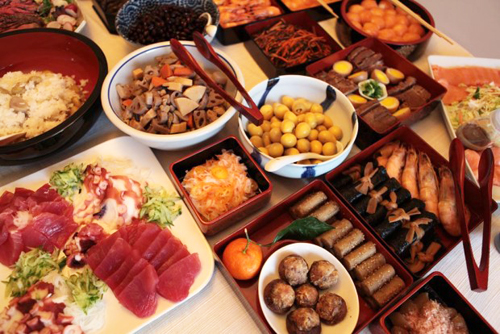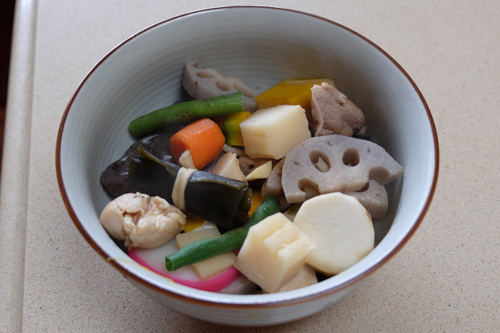Japanese New Year’s Day Tradition
Growing up in a Japanese American family, you don’t always celebrate holidays in the same way as your friends. An example of this is the New Years Day holiday. While many Japanese and Japanese Americans also celebrate New Year’s Eve, the more significant event is New Year’s Day itself. It is a day to celebrate with family and friends. A special selection of food, called osechi, is enjoyed that day. Eating these items is meant to bring you good luck for the coming year.
Umani, not to be confused with umami, is a Japanese stew. It is a dish that is often served on New Year’s Day. I knew my father enjoyed it, but it wasn’t until he passed away that I began to really enjoy the dish. I began requesting this dish from my mom as a tribute to my father and it has come to be one of my favorite Japanese dishes.
For last year’s New Year’s Day holiday meal, my sister asked me to make umani. Because there are many ingredients and most are cooked separately, this is a labor intensive dish. My sister gets a kick out of testing my culinary abilities and not wanting to succumb to my ego, I accepted her challenge.
Most of the ingredients can be found in a market that provides Japanese food products. In the LA area this includes Marukai and Nijiya. Because this dish contains many different prepared vegetables, I strongly suggest that you have at least 8 small bowls that you can store everything until you place them into the stockpot.
Ingredients:
- 1 lb. skinless/boneless chicken thighs
- 4 carrots
- 1 lb fresh green beans
- satoimo – small taro root potatoes
- renkon – lotus root
- gobo – burdock root
- takenoko – bamboo shoots
- konbu – edible kelp (usually found dried)
- shiitake mushrooms
- kabocha – Japanese pumpkin
- konnyaku – yam cake (get the grey one if available)
- shoyu – soy sauce
- mirin – Japanese rice wine
- sake – alcoholic beverage made from fermented rice
- hondashi – bonito flavored dashi-soup stock
- sugar
Preparation
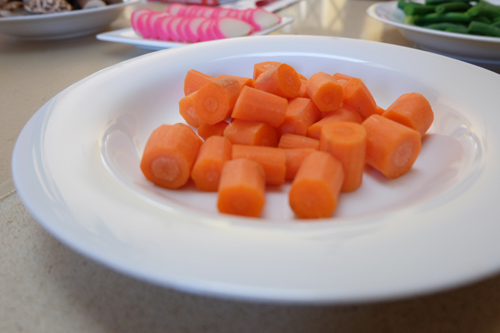 Peel the carrots and slice them in bite size pieces to your liking. Drop them into a pot of boiling water for five minutes. Drain and set them aside.
Peel the carrots and slice them in bite size pieces to your liking. Drop them into a pot of boiling water for five minutes. Drain and set them aside.
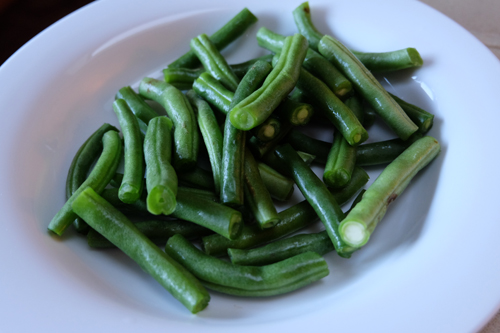 Slice the green beans into 2” pieces. Parboil them so that they don’t lose their vibrant color. Drain and set them aside.
Slice the green beans into 2” pieces. Parboil them so that they don’t lose their vibrant color. Drain and set them aside.
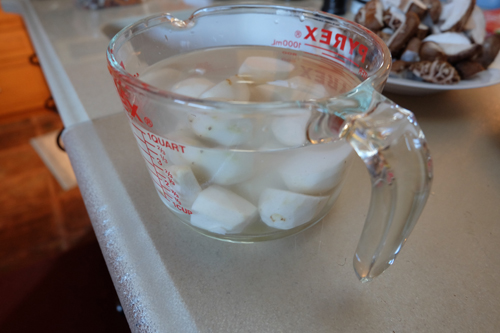 Rinse the satoimo (taro root potatoes) under cold water. Use a vegetable peeler to remove the tough exterior. Slice them so that they are bit sized (usually in half). Once peeled, place them in cold water so that you avoid discoloration.
Rinse the satoimo (taro root potatoes) under cold water. Use a vegetable peeler to remove the tough exterior. Slice them so that they are bit sized (usually in half). Once peeled, place them in cold water so that you avoid discoloration.
Peel the exterior of the renkon (lotus root). Slice in half lengthwise. Drop both items into a pot of boiling water for 2 minutes. Remove and set aside.
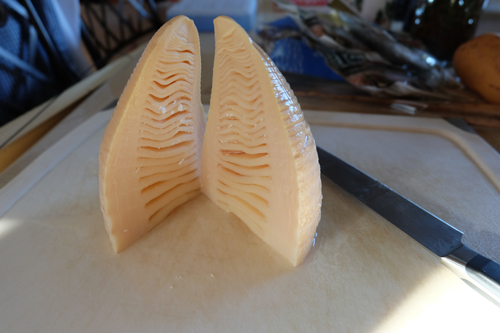 Takenoko – If you’re fortunate to buy this fresh you will see it packaged this way. Remove the wrap and slice in half lengthwise. Place in boiling water for 2 minutes. If you used canned takenoko, please make sure that each piece is bite sized.
Takenoko – If you’re fortunate to buy this fresh you will see it packaged this way. Remove the wrap and slice in half lengthwise. Place in boiling water for 2 minutes. If you used canned takenoko, please make sure that each piece is bite sized.
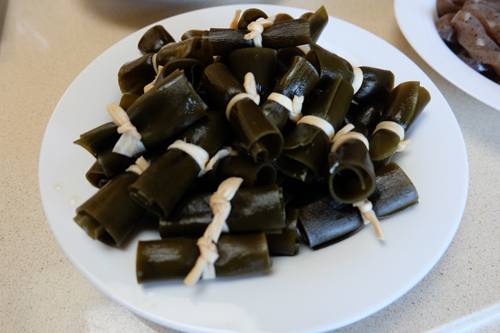 Konbu is edible kelp. Although you may be able to find this fresh, I’ve always purchased the dried version sold in cellophane bags. Fill a mixing bowl with cold water and drop the konbu in to reconstitute.
Konbu is edible kelp. Although you may be able to find this fresh, I’ve always purchased the dried version sold in cellophane bags. Fill a mixing bowl with cold water and drop the konbu in to reconstitute.
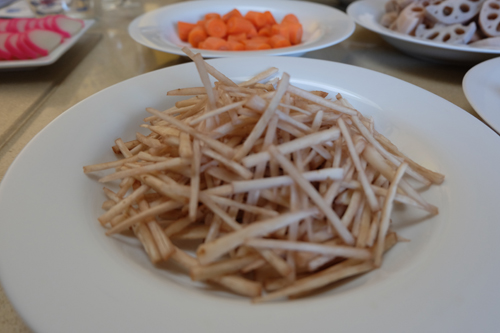 Gobo is a long skinny root which is brownish in color. Because burdock is very tough, I opted to ‘match stick’ slice them so that my family would not have to chew that much. My mom later told me that once gobo is cooked, it softens quite a bit. Thus, it’s probably better to create bite size pieces so the shape more or less matches your other items.
Gobo is a long skinny root which is brownish in color. Because burdock is very tough, I opted to ‘match stick’ slice them so that my family would not have to chew that much. My mom later told me that once gobo is cooked, it softens quite a bit. Thus, it’s probably better to create bite size pieces so the shape more or less matches your other items.
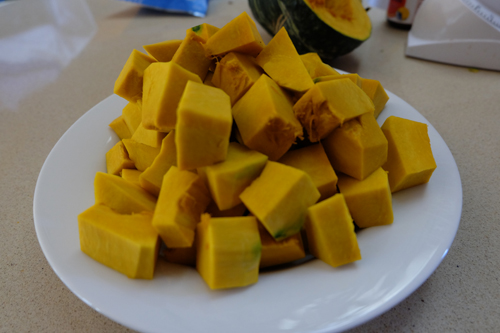 Kabocha is a Japanese pumpkin with a rough dark green skin. The exterior skin is very tough and difficult to slice in half. Once you’ve managed to slice it in half, scrape out the interior and the seeds. Peel the exterior skin and slice into bite sized pieces. Some, like my mom, like to leave the skin on as it adds additional color to the dish.
Kabocha is a Japanese pumpkin with a rough dark green skin. The exterior skin is very tough and difficult to slice in half. Once you’ve managed to slice it in half, scrape out the interior and the seeds. Peel the exterior skin and slice into bite sized pieces. Some, like my mom, like to leave the skin on as it adds additional color to the dish.
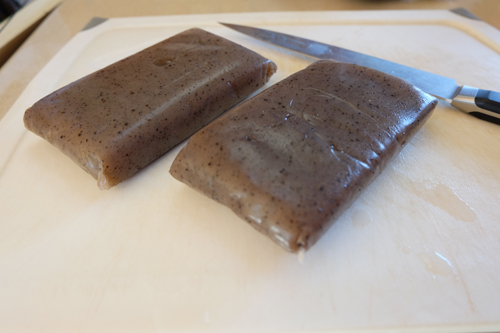
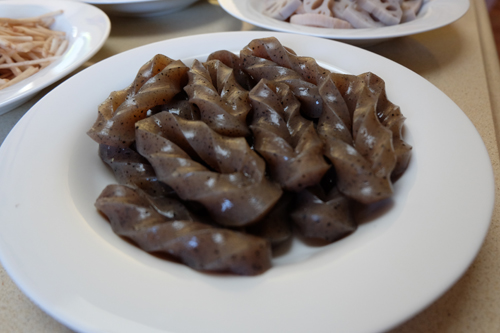 Konnyaku is a yam cake. The Japanese call it inohouki (broom of the stomach) because it’s useful for cleaning out the small intestines. After removing from the plastic packaging, slowly lower it into the boiling water for a minute. Along its width, slice the konnyaku into ½” pieces. If you place a slit in the middle of the ½ inch slice and wrap and end through the hole, you will wind up with a nice braid. This really adds to the presentation of the dish.
Konnyaku is a yam cake. The Japanese call it inohouki (broom of the stomach) because it’s useful for cleaning out the small intestines. After removing from the plastic packaging, slowly lower it into the boiling water for a minute. Along its width, slice the konnyaku into ½” pieces. If you place a slit in the middle of the ½ inch slice and wrap and end through the hole, you will wind up with a nice braid. This really adds to the presentation of the dish.
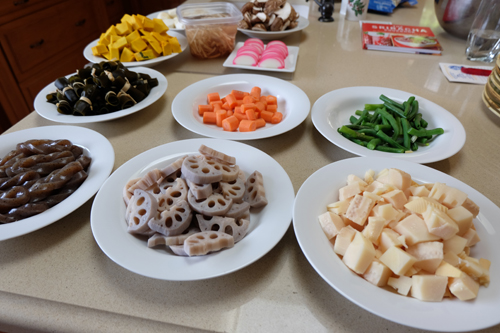 Finally, slice the chicken thighs into uniform bite size pieces. Place 2 tsp of oil into a fry pan and turn the heat to high. Lay the chicken into the hot pan and stir frequently to brown. If the pieces are small, you won’t need to cook the chicken thoroughly as it will have a chance to cook once it’s combined with the other ingredients.
Finally, slice the chicken thighs into uniform bite size pieces. Place 2 tsp of oil into a fry pan and turn the heat to high. Lay the chicken into the hot pan and stir frequently to brown. If the pieces are small, you won’t need to cook the chicken thoroughly as it will have a chance to cook once it’s combined with the other ingredients.
Take the chicken out of the fry pan and pat it down with some paper towels. If you sautéed the chicken in the stock pot, make sure that you clean it so that you remove the excess oil and fat.
In a sauce pan, add ½ cup shoyu, 6T mirin and sugar, and 6T sake with 2 cups water. Stir to dissolve the sugar. Add 2 tsp hondashi and stir again. Bring to a boil then remove from the stove.
Using the stock pot, add the cooked chicken. Next pour the shoyu, mirin, sugar, sake mixture into the stock pot. Cook using medium heat.
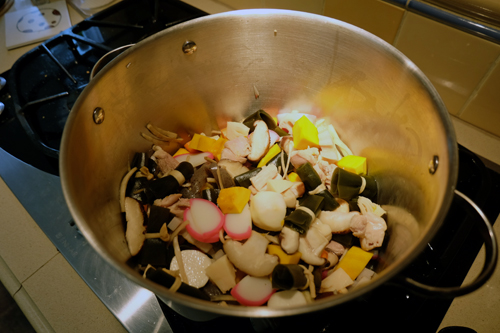 With the exception of the green beans and the konnyaku, add the remaining ingredients to the stock pot and occasionally stir the mixture. I like to add to add the green beans later because otherwise they will lose their bright green color. If you handle the konnyaku too much, they will begin to fall apart; thereford I like to add this at the end.
With the exception of the green beans and the konnyaku, add the remaining ingredients to the stock pot and occasionally stir the mixture. I like to add to add the green beans later because otherwise they will lose their bright green color. If you handle the konnyaku too much, they will begin to fall apart; thereford I like to add this at the end.
The mixture can be served immediately or left simmering on the stove. I wouldn’t leave it on the stove too long as your delicious broth will begin to evaporate.
